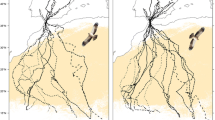Summary
Reoriented autumn migration of chaffinches and bramblings occurs regularly in southernmost Sweden. The reoriented birds fly in a northeasterrly direction from the coast and inland, i.e. approximately opposite to the normal autumn migration direction. The daily peak of reoriented finch migration, as observed at inland sites 20–40 km from the coast, occurs on average 3.5 h later than the early morning departure in the normal migratory direction, and 1 h later than the peak of migration at the coast. According to trapping data the average weight of reoriented migrants and birds interrupting their migration at the coastline is significantly lower than the weight of migrants proceeding in the normal direction, and the proportion of yearlings seems to be larger in the former category. Censuses of flocks of resting finches showed that they mainly forage at stubble fields of summer rape Brassica napus, preferably fields surrounded by wooded vegetation offering shelter from predator attacks. Preferred food and habitats are mostly located inland, 20 km or more from the coast. These findings are consistent with the interpretation that reorientation constitutes an adaptive response by migrants with small fat reserves. When confronted with an ecological barrier, they return to suitable resting sites for restoring the fat reserves before crossing the barrier.
Similar content being viewed by others
References
Ackman RG (1983) Chemical composition of rapeseed oil. In: Kramer JKG, Sauer FD, Pigden WJ (eds) High and low crucic acid rapeseed oils. Production, usage, chemistry and toxicological evaluation. Academic, New York, pp 85–129
Alerstam T (1978a) Reoriented bird migration in coastal areas: dispersal to suitable resting grounds? Oikos 30:405–408
Alerstam T (1978) Analysis and a theory of visible bird migration. Oikos 30:273–349
Alerstam T, Ulfstrand S (1975) Diurnal migration of passerine birds over South Sweden in relation to wind direction and topography. Ornis Scand 6:135–149
Blem CR (1976) Patterns of lipid storage and utilization in birds. Am Zool 16:671–684
Brusewitz G, Emmelin L (1985) Det föränderliga landskapet. LTs förlag, Stockholm
Dolnik VR, Blyumental TI (1967) Autumnal premigratory and migratory periods in the chaffinch (Fringila coelebs coelebs) and some other temperate-zone passerine birds. Condor 69:435–468
Dolnik VR, Gavrilov VM (1973) Energy metabolism during flight of some passerines. In: Bykhovski BE (ed) Bird migrations. Ecological and physiological factors. Wiley, New York, pp 288–296
Evans PR (1968) Reorientation of passerine night migrants after displacement by the wind. Br Birds 61:281–303
Haartman L v (1945) Umschlagende Zugrichtung beim Buchfinken Fringilla c. coelebs L., im Herbst. Ornis Fenn 22:10–16
Haartman L v, Bergman G, Koskimies J (1946) Beobachtungen über umschlagende Zugrichtungen der Bachstelze, Motacilla a. alba L., im Herbst. Ornis Fenn 23:50–62
Metcalfe NB, Furness RW (1984) Changing priorities: the effect of pre-migratory fattening on the trade-off between foraging and vigilance. Behav Ecol Sociobiol 15:203–206
Newton I (1972) Finches. Collins, London
Nøhr H (1984) The winter occurrence of bramblings and wood pigeons in south Sweden and Denmark in relation to the beech mast crop as measured in Denmark. Vår Fågelvärld 43:241–243 (English summary)
Pettersson J, Hasselquist D (1985) Fat deposition and migration capacity of robins Erithacus rubecula and goldcrests Regulus regulus at Ottenby, Sweden. Ring & Migr 6:66–76
Richardson WJ (1978) Timing and amount of bird migration in relation to weather: a review. Oikos 30:224–272
Richardson WJ (1982) Northeastward reverse migration of birds over Nova Scotia, Canada, in autumn. Behav Ecol Sociobiol 10:193–206
Roos G (1974) Simultaneous observations of visible autumn migration at different sites near Falsterbo — a pilot study. Anser 13:137–148 (English summary)
Roos G (1984) Migration, wintering and longevity of birds ringed at Falsterbo (1947–1980). Anser [Suppl 13], Lund (English summary)
Simmonds DH, Campbell WT (1976) Morphology and chemistry of the rye grain. In: Bushuk W (ed) Rye: production, chemistry and technology. American Association of Cereal Chemists, Inc, St. Paul, pp 63–110
Zisweiler V (1965) Zur Kenntnis des Samenöffnens und der Struktur des Gaumens bei körnerfressenden Oscines. J Ornithol 106:1–48
Author information
Authors and Affiliations
Rights and permissions
About this article
Cite this article
Lindström, Å., Alerstam, T. The adaptive significance of reoriented migration of chaffinches Fringilla coelebs and bramblings F. montifringilla during autumn in southern Sweden. Behav Ecol Sociobiol 19, 417–424 (1986). https://doi.org/10.1007/BF00300544
Received:
Accepted:
Issue Date:
DOI: https://doi.org/10.1007/BF00300544




